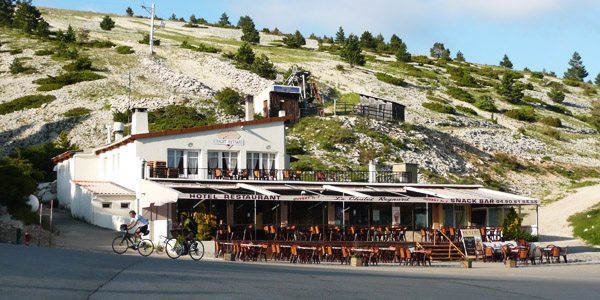A climb like no other. Mont Ventoux has always been much more than just a road.
Attention, Ferdi – the Ventoux isn’t a climb like any other, Raphael Geminiani warned his teammate in the 1955 Tour de France. Standing alone, roughly half-way between the Alps and the Pyrenees, the Mont Ventoux doesn’t resemble either, and its exposure to the elements particularly the Mistral winds and intense summer heat has helped the mountain achieve a mythical status among cyclists.

The road that zigzags up the 1912m to the summit and back down again is a frequent highlight of the Tour de France and has consequently become a ‘must do’ challenge for passionately dedicated cyclists. The season for testing your mettle on the Mont Ventoux climb runs from April to November. Snowfall prevents you reaching the top at the height of winter.
British cycling legend, Tommy Simpson, won the Tour de France in 1967, but just four months later collapsed and died of heart failure on the slopes of Mont Ventoux. Around the treeline is a memorial to the great British cyclist. Bradley Wiggins finished fourth in the 2009 Tour, and when he climbed the Ventoux he had a picture of Simpson glued to his bike frame.
Mont Ventoux is visible from 100km in all directions and the barren pebbles of the final 300m give the mountain the illusion of being snow-capped year round. As a result, the mountain is sometimes referred to as the Mont Chauve, or ‘Bald Mountain’.
It’s not just the gradient that makes the Ventoux a tough climb, it’s also the weather. The Mont Ventoux ridge is battered by fierce Mistral winds 130 days a year, winds which gave the mountain its name – Mont Ventoux means literally, windy mountain. Winds of over 300km an hour have been recorded here. The locals don’t need to rely on meteorological instruments to know how windy it is. As said by the owner of the Chalet Liotard, 1,432m high, “when the chalet walls start to move, we know it’s blowing hard”.
Geminiani had told Ferdi Kubler during the 1955 Tour de France, “Be careful, the Ventoux isn’t a climb like any other”. Kubler was a high-spirited and impulsive rider and chose not to listen. He reached Malaucène in a state of delirium and refuelled in Le Pontet on beer and ‘other substances’, which didn’t help. A spectator tried to stop him from setting off for the climb in the wrong direction. Kubler’s otherwise distinguished cycling career lasted just one more day.
Lance Armstrong argued that the Mont Ventoux climb disliked him and not the other way around, but he also accurately identified that the lack of oxygen and vegetation at the top are two reasons the climb from Bédoin is one of the hardest in cycling. Geminiani suggested that “with the Ventoux, people always exaggerate” and maintained that “the climb is simply hot and hard, no more than that”.
Nevertheless, after five and half kilometres of climbing, banking hard left in the village of Estève has been described as like entering a gas chamber, as the road judders straight and then barely deviates for the next ten kilometres up to Chalet Reynard. There, a different climb begins, tacking northwest across the lunar landscape, often into the wind. This is where Simpson perished. To make matters worse, you can see the finish line almost throughout the final six kilometres.
Tackling the climb from Malaucène is steadier and less haunted by tales of suffering than the brutal climb from Bédoin, but whichever way you choose to ride, the Mont Ventoux remains one of cycling’s greatest and hardest climbs.
Please leave a comment below if you need specific advice for your cycling trip to the Mont Ventoux, or if you have any recommendations to help us improve this page. Happy holidays!




